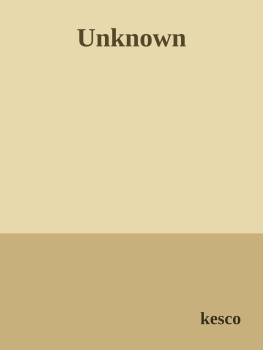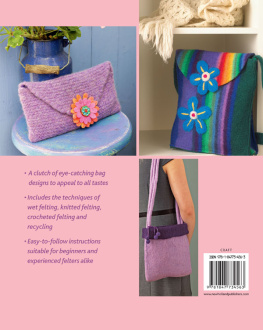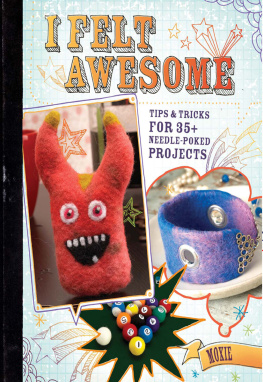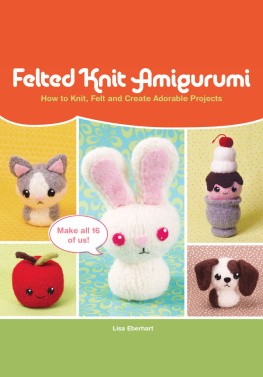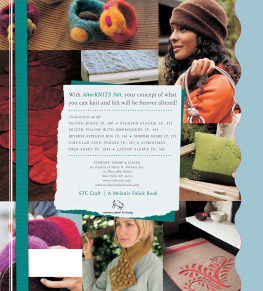Knit One, Felt Too
DISCOVER THE MAGIC OF KNITTED FELT WITH 25 EASY PATTERNS
Kathleen Taylor

THIS BOOK IS FOR MY MOM, LONA PRATER,
WHO TAUGHT ME HOW TO KNIT, AND FOR MY GRANDDAUGHTERS,
ADDY JO AND SOPHIE, WHOM I HOPE TO TEACH.
The mission of Storey Publishing is to serve our customers by
publishing practical information that encourages
personal independence in harmony with the environment.
Edited by Gwen Steege and Margaret Radcliffe
Art direction by Cynthia McFarland
Cover and text design by Vertigo Design NYC
Cover and text photography by Ben Fink
Color consultant for knitted projects: Leslie Voiers
Illustrations on pages 7157 by Elayne Sears and on pages 17174 by Alison Kolesar
Text production by Jennifer Jepson Smith
Indexed by Susan Olason, Indexes & Knowledge Maps
2003 by Kathleen Taylor
All rights reserved. No part of this book may be reproduced without written permission from the publisher, except by a reviewer who may quote brief passages or reproduce illustrations in a review with appropriate credits; nor may any part of this book be reproduced, stored in a retrieval system, or transmitted in any form or by any means electronic, mechanical, photocopying, recording, or other without written permission from the publisher.
The information in this book is true and complete to the best of our knowledge. All recommendations are made without guarantee on the part of the author or Storey Publishing. The author and publisher disclaim any liability in connection with the use of this information. For additional information please contact Storey Publishing, 210 MASS MoCA Way, North Adams, MA 01247.
Storey books are available for special premium and promotional uses and for customized editions. For further information, please call 1-800-793-9396.
Printed in Hong Kong by Elegance Printing
10 9 8 7
LIBRARY OF CONGRESS CATALOGING-IN-PUBLICATION DATA
Taylor, Kathleen, 1953
Knit one, felt too: Discover the magic of knitted felt with 25 easy patterns/by Kathleen Taylor.
p. cm.
ISBN 978-1-58017-497-8 (alk. paper)
1. Knitting-Patterns. 2. Felting. I. Title.
TT820.T36 2003
746.482043-dc21 2003050558
Contents

1
Honey, I Shrunk Your Sweater
I grew up in the Polyester Era, so I was middle-aged before I personally encountered the Shrunken Sweater Syndrome, though I knew a few unlucky souls who accidentally machine washed an expensive wool sweater with unfortunate results. I assumed that wool was delicate and that merely washing it made it shrink. But Ive since learned that rather than the washing that causes the shrinkage, its the combination of hot water, agitation, and detergent that causes the scales on the wool fibers to lift and adhere to each other. That adherence causes the fabric to contract, and that contraction causes the wool to shrink and become thick and fuzzy.
The Magic of Knitted Felt
Unplanned thick fuzziness can cause us to scream and tear our hair out, especially when we discover that a $400 cashmere sweater no longer fits anyone over the age of three. But once youve created that loose-knit, oversize object that you actually intend to shrink, youll discover that you can use wools natural shrinking ability to your advantage and youll become completely hooked on knitted felt. Taking control is not as difficult as you might think, as youll soon find out when you knit your first project and felt it, too. How you go about the felting process, the materials you use, and the length of time you agitate the wool all have a bearing on how the project shrinks.
FIRST I DID IT THE HARD WAY
My very first knitted felt project was a wool roll-brim cap. Following the hints I found on the Internet, I used big needles to knit a hat that would fit a giant, and then dropped it into a sink full of hot, soapy water, and waited gleefully for it to turn into lovely, thick felt. I swished it around. I swooshed it around. I scrubbed and twisted and sloshed it until my hands turned to prunes. I worked on that hat until my wrists felt like they were going to fall off. As directed, I periodically plunged it into a bowl of icy water.
After forty-five minutes of intense labor, I had a really clean hat that hadnt shrunk at all.
I scrubbed some more.
I plunged some more.
I continued until I thought I was going to drop, and the silly hat still didnt felt.
THEN I DID IT THE EASY WAY
I asked around and was assured that if I continued scrubbing, the hat would eventually turn into felt. Eventually sounded like a very long time, so I threw it in the washing machine. I set the load for as small as the machine would allow. I set the water temperature to Hot Wash/Cold Rinse and added some detergent. I turned the machine on, and then I listened to some music while the washer did the work for me.

Believe it or not, the floppy, oversized bag in progress on the left really will shrink down and shape up to look like the stylish hat on the right after being felted.
Of course, it didnt do the work all at once. After one complete washer cycle, I inspected the hat. Sure enough, it had shrunk some, but it was still way too big. So I washed it again.
After the second complete washer cycle, I checked again. The hat had shrunk even further, and it was starting to look more like fuzzy felt than soggy knitting. But it was still too big. So I washed it again.
Finally, after the third complete washer cycle, the hat was perfect! The formerly loose and floppy hat was now thick and fuzzy. The wool fibers expanded and wrapped around each other, locking together and creating a tight fabric through which no winter wind could blow. The colors had muted beautifully, and best of all, the hat fit perfectly.

Its all in the fibers: This drawing shows greatly enlarged wool scales prior to felting. During the washing process they will open, tangle, and close again.
AND ONCE I EVEN TRIED IT THE SMELLY WAY!
Another term for knitted felt is boiled wool. So, in the spirit of another experiment, I tried boiling a hat on my stove. I used a big old canning pot that Id found at a rummage sale. The heat and agitation of heavy boiling, alternated with plunges into a bowl of icy water, did the trick in about an hour.
It worked, but there were drawbacks. What did you do, my husband asked, wrinkling his nose when he came home for lunch, kill a sheep in here?
Theres no getting around the fact that wet wool smells like wet wool. And if you boil wool in your kitchen, your whole house is going to smell like wet wool. Of course, if you felt the wool in your washing machine, youre going to get a little eau de damp sheep there, too, but it wont be as strong, or as pervasive, as when you simmer items on the stove. I happen to like the smell of wet wool, but Im in the minority in my family.





